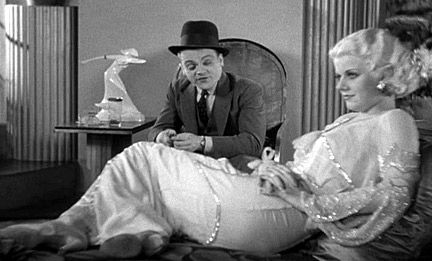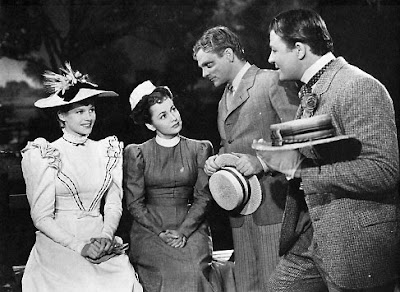This is my entry in the Classic Movie Blog Association's Movies are Murder Blogathon. Click here for more movie murder and mayhem.
The Public Enemy:
The Killer Must Be Killed
 |
| This |
As most likely know, there are murders aplenty in The Public Enemy (1931). There are those anonymous gang members caught in the spray of a tommy gun and there are those of the specific nature - retribution for disloyalty or double crossing ratness. And then there are those of the innocent. The innocent deaths are the ones that hurt the most.
 |
| Tom and Matt handle a gun for the first time |
I don't mind saying that the first time I saw "The Public Enemy," it scared the bejesus out of me. From the eerily disconcerting "I'm forever blowing bubbles" played on a gramophone to that final murder, it still gives me the chills to this day. That dull thud of a lifeless body before the fade out is right up there with all of those movies that deliberately try to scare you (thinking "The Exorcist" and "The Omen" and the like).
 |
Oozing murderous charm
|
And yet there is also something compelling about this film that makes it so complicated, something that jazzes the whole nasty story up, and that disconcerting something is James Cagney as Tom Powers. Cagney was originally and famously cast as second banana Matt, but director William Wellman demoted Edward Woods, the original Tom, to the role of Matt and re-cast Cagney as Tom. It proved to be a brilliant move. His on the make charm, that jaunty little spin he takes when he see he has a chance with Jean Harlow's Gwen, his self confident strut when he shows up in his new clothes, all make for an unsettling confusion. If this guy is so bad, why can't I dislike him?
As Tom and boyhood buddy Matt Doyle drift from a brutal and impoverished childhood into a life of petty crime (they never rise above being trusted lieutenants to boss Paddy Ryan), the first murder they witness is that of their boyhood friend, Larry Dalton. Tom and Matt and Larry, all barely men, are enlisted by gangster Putty Nose to rob a fur warehouse. Things go wrong and Larry is shot and killed by a cop, who Tom shoots before escaping with Matt. Frightened, they go to Putty Nose for help (he has promised to protect them), but they are turned away and forced to fend for themselves. As the neighborhood mothers weep over the loss of a young man who went wrong, Tom and Matt get their first glimpse of a dead body at Larry's funeral. But it won't be their last.
 |
| After you see your first friend in a coffin, it gets easier |
As Prohibition becomes the law of the land, Chicago crime boss Paddy Ryan recruits Tom and Matt as his "beer salesmen." Strong-arming saloon keepers for their bootleg beer, Tommy and Matt muscle their way through their life of crime.  |
| Tom makes clear his distaste for a rival supplier's product |
For a while, they are riding high. New clothes and new women make life even sweeter. Tom is a charming brute. He picks up the unfortunate Kitty, but eventually tires of her, giving her the famous "citrus massage" in her puss.
 |
| Harlow as Gwen: her acting is green, but her allure is platinum |
 |
Mae Clarke as Kitty receives the cinema's most famous facial
|
He moves up to the more glamorous tart Gwen. Jean Harlow, in an early performance, is pretty terrible. But, as bad as she is, there is an undeniable allure about her and she sure wiggles her caboose in an unforgettable manner. Tom is also is taken under the wing of fancy gangster, Nails Nathan. Nathan is a sort of mentor to Tom, a "class" guy that Tom look up to aspires to emulate.
And then there is Putty Nose. Ah Putty Nose, the dirty double crossing rat who left Tom and Matt holding the bag after the bungled fur warehouse job. Tom does not forget and poor old Putty Nose - well, he had it coming. Can't say I felt bad. He was the groomer who lured Matt and Tom into a life of crime. After doing away with the craven Putty Nose who begs for his life, Tom coolly turns towards the door and wonders if he can still get together with Gwen. A psychopath does have his needs.
 |
| Say your prayers, Putty Nose |
So, the thing about Tom that softens me to him, beside his obvious charm, is his admittedly twisted code of honor. In a world where people are double-crossing and selling out one another so fast it makes your head spin, Tom's loyalty to his friends is kind of admirable. I told you this was complicated.
 |
Nails Nathan before his fateful ride
|
Matt's murder in a shoot out with the rival Schemer Burns gang (live by the gun, die by the gun, I suppose), sends Tom on a vengeful mission. He is outgunned, but somehow manages to survive. Well, that wasn't his enemies' plan and, wrapped like a junior king tut, his lifeless body is delivered to his annoying mom and goody two-shoes brother, the final murder in a murderous tale.
 |
| Vengeance is Tom's |
Tom Powers is no better or worse than so many of his contemporaries, but there is one other murder in "The Public Enemy" that I can't accept as remotely justified. Unlucky for Tom, just when he is finally making some headway with the hard to get Gwen, Matt appears and tells him the bad news: Nails Nathan has been killed. And not killed by a rival gang, but by his horse. Dandy-wannabe Nails, decked out in his best English riding habit, was thrown by his mount and died as a result of a hoof to the head. Tom, true to his code, has to kill the killer of the man he so admired and, with a single shot, committs equinecide (I know, not a word, but it could be). Honestly, if the guy was a better rider he probably would not have been thrown*. Mercifully, the murder takes place off screen. There is a shot and a sad neigh.
 |
Where's that horse?
|
And so, I find myself sadder and madder over the murder of an unknown and unseen horse than over the murders of Larry, a cop, Putty Nose, Matt and, ultimately Tom. In a way (other than the cop, who faced potential harm in 1920s Chicago), they all had it coming. But not the horse. If you're the person who cries harder when the dog dies in the film than when the human does, you know what I'm talking about. And when Tom Powers takes that final flop at the feet of his mother and brother, I am pretty sure, to paraphrase Zuzu in "It's a Wonderful Life," every time a horse-murdering gangster buys the farm there is a happy neigh in heaven.
 |
Special delivery
|
* The murder of the horse is actually based on a true story (as is much of this film). True life gangster Samuel "Nails" Morton was a flashy mobster who took a liking to riding his mount in Chicago's Lincoln Park. When his horse (obviously one on the side of law and order) threw Morton and then fatally kicked him in the head, Morton's compatriot Louis "Two-Gun" Alterie, took the horse out for a ride, shot him and left him for dead.


















































